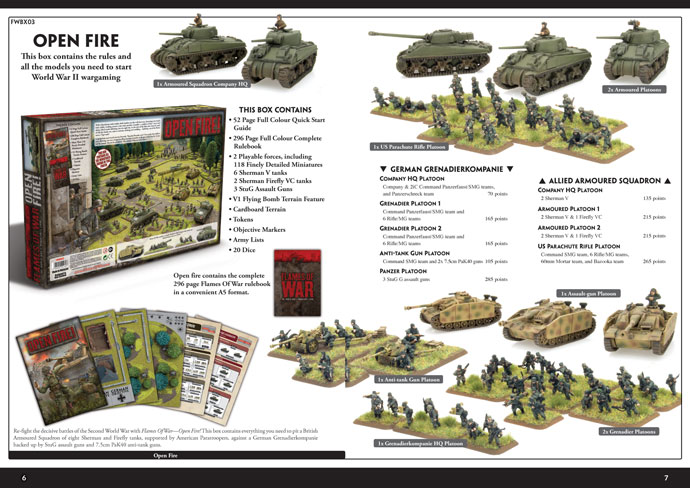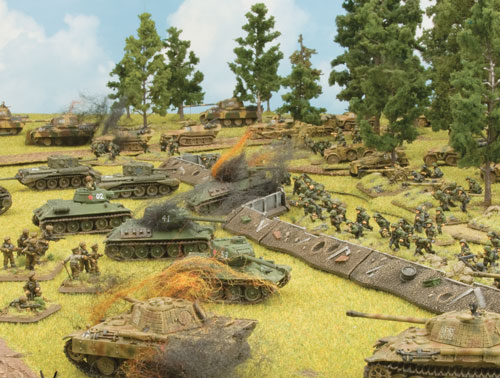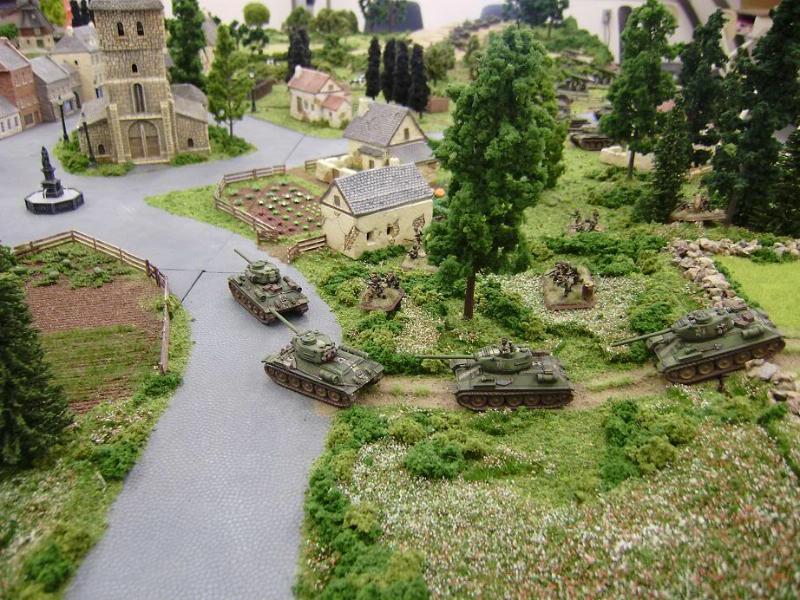The Second World War has been done to death in modern media, from video games such as the the excellent Company Of Heroes series that has recently got its second installment, TV series like the equally good Band of Brothers and of course the plentiful supply of movies like Saving Private Ryan. Its easy to say that World War 2 still has a significant place in modern culture. Flames of War draws on this wealth of material to create a game that is enormously simple to play but rewards tactical thinking over all else.
The game is split into three periods, Early War which spans 1939-1941 and covers the German Blitzkreig and the beginning of the war, Mid War which spans 1942-1943 and covers events like the war in Africa and Monte Cassino, finally there's Late War which is the most popular period which spans 1944-1945 and covers the Allied invasion of Nazi controlled Europe and the German push into Russia. As the game is based on events that actually happened, different armies are stronger at different periods and of course different units are available at different times as hardware was upgraded and obsolete equipment was retired.
Unlike other games, the army books are divided into theatres for each country with a counterpart for the Axis and Allies, for example the book Earth and Steel covers the German defence of Europe and the Allies counterpart Turning Tide covers the invasion of Normandy. Historic units are represented for each side and have been researched to the highest degree, the books are meaty and full of content including detailed background on each of the regiments and units, there are also select 'characters', historic unit leaders and commanders that can change the way armies work.
 | |
| The Open Fire! box set contains a good selection of models and rulebooks |
When first starting out with Flames of War you will have to decide which side you're on, Axis or Allies and you'll also have to decide which country you want to use, these decisions will affect which army book you will pick up. The Open Fire! box set is a great starer kit and contains decent starter forces for the German and Allied forces giving you a Panzergrenadier Kompanie and American force with some British Commandos. Putting together a force for a game is, like most wargames, is based on points and a force organisation chart. Unlike most wargames this will vary depending on which regiment you have chosen to represent, in your chosen army book you will be presented with lots of pages that look like this:
 | |
| A typical page from an army book, don't panic! |
First off, don't panic. Some of these can look quite intimidating, you will need to include one selection from each black box, in the above example there is only one choice but sometimes you will have two or three to choose from. You can also include one selection from each of the grey boxes but you will probably not have the points to do so. The number to the right of each entry relates to a page in the book that detail the unit further including points costs and any unit upgrades available.
 |
| Allied forces besiege the entrenched Germans |
With your scenario determined and your armies set up, you can now start to play the game, movement is as you'd expect from a wargame, standard movement for infantry with vehicles having difficulty in broken ground, one major difference is 'bogging down' which depending on the skill of the drivers, can see tanks and other vehicles get stuck in forests etc. Shooting at the enemy uses a mechanic that I think is unique to this game firing on the enemy is based not on the skill of your soldiers but the skill of the enemy, there are no stats to think about other than the enemy skill rating, there are modifiers based on range, concealment and terrain.
Now is a good time to talk about the effects of terrain, cover is good. Solid cover like a building or walls grant your units concealment and bulletproof cover which makes entrenched infantry hard to hit and very hard to kill, why is bulletproof cover so good? because you will need to take a firepower test to penetrate the cover, each weapon in the game has a firepower rating, the bigger the gun the higher the firepower rating. The firepower rating also determines how effective the weapon will be if it breaks the vehicles armour. Armour is also handled well, like shooting this is inverted when compared with other wargames with the defender rolling against the attackers Armour Penetration rating.
 |
| A tank company assaulting a sleepy village- probably in France |
Tanks require a tactic all of their own, they have very heavy weapons that can punch through other tanks but you will need very careful positioning to get the most out of them, the side armour is often very thin and won't stand up to any return fire, they are also extremely vulnerable to aircraft, which will fly up behind them, hit them in their paper thin rear armour and destroy them quickly.
The game does have its downsides however, because it is based on actual events and actual units that have been historically researched, the game is not always balanced as well as it could be, with Allies often being a little stronger, particularly in tank battles. This balances out however, as mentioned above different armies are stronger at different periods during the war.
Onto the models then, aside from the contents of the Open Fire! box which are plastic, the models are a mix of resin and metal, these are hugely detailed for their scale and look decent enough, the main goal here is not paint up everything in massive detail, that would be impossible at that scale, focus on making units look good is more important than making each model look amazing.
If you're interested in Flames of War, head over to their website and take a look.


No comments:
Post a Comment